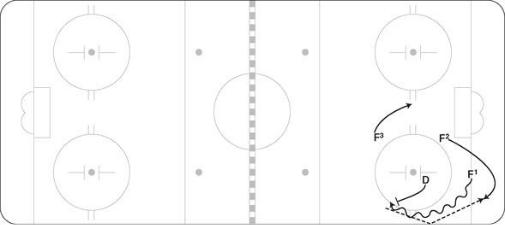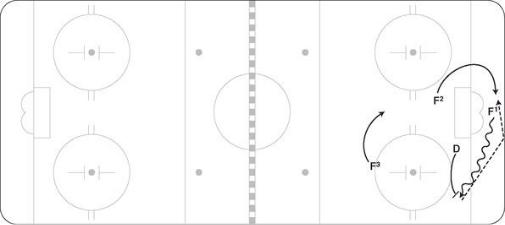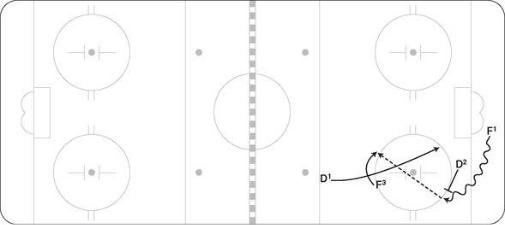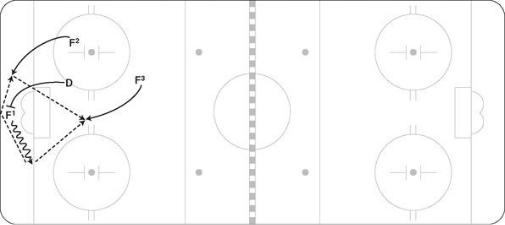
- •Foreword
- •Preface
- •Key to Diagrams
- •Reading Pressure and Options
- •Reacting to Support the Breakout
- •Breakout Plays
- •Control Breakouts
- •Counters
- •Regroups
- •Dump-In Entries
- •Mid-Ice Entries
- •Wide-Lane Drives
- •The Funnel
- •Two-on-One Attacks
- •Two-on-Two Attacks
- •Three-on-Two Attacks
- •Offsides
- •Activating Defense Into Offensive Zone Entries
- •Cycling
- •Playing Behind the Net
- •Stretching the Zone: Low-High Plays
- •Activating Defense in the Offensive Zone
- •Attack Zone Plays
- •Power-Play Breakouts
- •Gaining and Maintaining Possession off the Entry
- •Zone Setup
- •Five-on-Three Power Play
- •Four-on-Three Power Play
- •Forechecking Systems
- •Neutral Zone Forechecking
- •Neutral Zone Forechecking Systems
- •Neutral Zone Backchecking
- •Neutral Zone Backchecking Systems
- •Handling Defensive Zone Entries
- •Defensive Zone Systems
- •Situational Guidelines for Defensive Zone Coverag
- •Face-Offs and Penalty Kills
- •Forechecking and Penalty Kills
- •Pressuring the Entry
- •Defensive Zone Play
- •Three-on-Five Penalty Kill
- •Three-on-Four Penalty Kill
- •Offensive Zone Face-Offs
- •Neutral Zone Face-Offs
- •Defensive Zone Face-Offs
- •Power-Play Face-Offs
- •Penalty-Kill Face-Offs
- •Special Face-Off Situations
- •Managing Staff
- •Dealing With Officials
- •Adjusting Your Playing Strategy
- •Managing Lines
- •Line Changes
- •Handling the Moment
- •Index
- •About the Authors
Cycling
Many offensive strategies include cycling the puck. Younger, inexperienced players often get the cycling process wrong, so let’s start with this basic tactic. The cycle works best when the player with the puck deep in the offensive zone begins to bring the puck up the boards toward the blue line (figure 4.1). Generally a defender will press this puck carrier toward the boards and work to remove the puck. The key to the cycle setup is the second offensive forward. This forward mirrors the positioning of the puck carrier but stays 10 or 15 feet (3.0 to 4.6 m) away from the puck carrier on the boards, toward the goal line. This player calls for the puck. Here is where inexperienced players mess up. The tendency is for players to pass into open ice, but the cycle doesn’t work best this way. It works best when the puck is angled off the boards, away from the defender’s stick, so it bounces off the boards and onto the stick of the second offensive forward. Cycling is an effective tactic when executed correctly.
The purpose of the cycle is to keep possession of the puck and take it to the net to create a scoring chance. If the initial player with the puck can gain a lane to the net, he shouldn’t cycle—he should take the puck to the net. A pet peeve of many coaches is when players cycle for the sake of cycling and don’t read when to exploit the defenders. If the puck carrier feels pressure and knows the lane is shut down, he should lay the puck back to the corner where he came from. His support player (F2) needs to read this and move to support the cycle pass. Once this play is made, F2 may continue the cycle with a pass back to F3.
Figure 4.1 Cycling.

The three forwards should move in sequence from the boards to the slot to the net and back to the corner to support the cycle . . .
thus the name. The goal of the cycle is to pull a defender out of position and then attack the net or the seams with a quick pass to the open player. Opponents often get their coverage confused because of the quick rotation of players who cycle with the puck then lay it to the corner and work to get open. The cycle is not easy to continuously defend, and when defending the cycle a missed assignment means an offensive chance. The cycle works best along the side boards but can also be used near the back of the net.
The net cycle (figure 4.2) is another cycling option. If well executed, it pulls defenders from the front of the net toward the corner or behind the net, and this movement often opens up passing lanes for excellent scoring chances. It is similar to the side board cycle where one player skates behind the net with the puck and when pressured passes the puck back behind the net. Also it forces the goaltender to follow the play behind the net while trying to keep track of options in front, which is difficult.
Figure 4.2 The net cycle.

It is important off any cycle play to get the puck to the net quickly. Whether the cycle is on the side boards or behind the net, as soon as the first cycle pass is made that player should look to take the puck to the net or shoot the puck at the net right away. Quick plays like this catch the defensive team off guard and also catch the goaltender trying to adjust. In most situations when a quick shot is taken it will result in a rebound because the goaltender is not set. The other players going to the net should do so with their stick on the ice ready to play the rebound or for a potential shot pass play.
Playing Behind the Net
Wayne Gretzky played behind the net so well, that this area became known as his “office.” Gaining offensive positioning behind the net opens up many opportunities for direct-shot (highpercentage) chances. To effectively use the back of the net teams should automatically move the puck to this space when they don’t have another option. The offensive player at the net now reads his teammate is in trouble and moves to the back of the net area. When a pass is made to the back of the net the offensive team will always get there first because the defensive team never overplays this area. Using the back of the net forces the opposing defense and goaltender to focus on that area while losing track of where players are in front. Sometimes two defenders can be drawn into this area; if the defensemen are unsure of who should be covering the player behind the net, both may jump in at the same time. Now at least one offensive player will be open in the dangerous scoring area in front of the net.
Figure 4.3 Pressing the net.

One of the most effective plays from behind the net occurs when an offensive defenseman skates hard from the point (blue line) looking to receive a pass in the slot (figure 4.3). If the defenseman pressing the net is unable to receive a clear pass, the second option off of this play becomes very dangerous. As this defenseman moves to the front of the net—pulling as many defenders with him as possible—the boards-side forward steps into this “soft spot” vacuum and often gets to take a dangerous shot through the traffic created by the pressing defenseman.
The second play selection from behind the net (figure 4.4) is also hard to defend. The big decision that defenders must make about the offensive player standing behind the net with the puck is when or how they should flush him out from behind the net. If the defending defenseman attacks the offensive player from one side of the net, two options open up.. The first is that players in highpercentage scoring areas may be left open. The second option is for the player with the puck to reverse the flow and create some “back-door” deception. When flushed out, the player with the puck angles the puck (similar the half-boards cycle) to a teammate filling this flushed-out position. Defenders who were focused on the player being flushed out must now divert their attention back

toward the other side of the net. This refocus often opens up backdoor or back-side plays.
Figure 4.4 Options for a player being flushed from behind the net.
